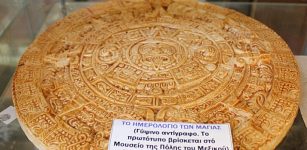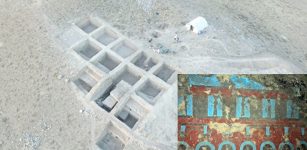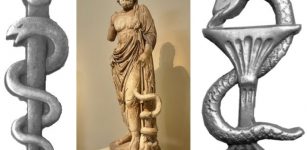Advanced Ancient Knowledge Of Chemistry – From Chrome Plating To Nanotubes
AncientPages.com - The ancient Babylonians were the first to use sophisticated geometry – a staggering 1,400 years before it was previously thought to have been developed. Sadly, these mathematical innovations were forgotten as the Babylonian civilisation collapsed and were only rediscovered this year as scientists took a close look at ancient clay tablets.
The Pantheon dome - made entirely out of concrete. MatthiasKabel/wikimedia, CC BY-SA
This surprising finding made me wonder about what other scientific methods that we put down to modern minds were actually discovered by ancient civilisations. So I decided to hunt down some of the most advanced uses of chemistry.
Qin Dynasty chrome plating
The mirrored shine of chrome-plated metal is almost a symbol of the modern era. A thin chrome layer coats metals and plastics in kitchens, bathrooms and cars. Credit for chrome-plating technology goes to George Sargent who published a method in 1920 that lead to the commercial plating that dominated the Art Deco period and beyond. In fact, other famous chemists including Robert Bunsen dabbled with chrome plating in the mid-19th century. But all of these may have been beaten to the shine by the metallurgists of the Qin dynasty in China some 2,000 years before chrome had even been identified in the West.
Qin dynasty sword on display. Mark Lorch/Flickr, CC BY-ND
In the 1970s, razor sharp swords coated in a thin layer of chromium oxide were unearthed along with the the famous Terracotta army. The Chinese suggest that their 1st dynasty weapon smiths coated officers’ weapons to protect them from corrosion. And indeed, two millennia later the blades are untarnished. However, whether this is really the case or in fact the chromium layer slowly formed from a peculiarity of the blade’s composition and the fires that ravaged the buried terracotta army is a matter of debate.
Roman concrete
Concrete is the mainstay of modern buildings, but ancient civilisations also used it to great effect. Concrete is a composite, meaning that it is made from two or more materials; cement is mixed with sand and gravel, which then sets into whatever structure is required. The most famous ancient concrete buildings are probably the Pantheon and Colosseum in Rome. Both are composed of fine volcanic ash mixed with lime (calcium hydroxide).
Colosseum in Rome. Diliff/wikimedia, CC BY-SA
Together these make the cement, which sets and binds fist sized pieces of limestone together. This particular recipe produces a network of crystals that resist propagation of cracks, the bane of modern concrete. The result is an incredibly enduring material that is, in many ways, superior to today’s concrete. A testament to this is the majestic roof of the Pantheon, which, at 43 metres across, is still the world’s largest unreinforced concrete dome.
Damascene nanotubes
Carbon nanotubes are the strongest and stiffest materials known. They consist of cylinders with walls that are just one atom thick. When used within composite materials they can massively enhance the strength of an object resulting in super strong and light components, some of which you can find in wind turbines, sports gear and vehicles.
18th-century Persian-forged Damascus steel sword. Rahil Alipour Ata Abadi/wikimedia
In 2006 researchers discovered that the people of Damascus were making use of nanotubes in their steel hundreds of years ago. The result was beautiful blades covered in swirling patterns. And more importantly for the soldiers of the time was the exceptional durability and the razor-sharp edges the steel held. We now know the exact composition of Damascus steel, yet modern metallurgists have failed to reproduce it so far.
See also:
Egyptian Blue: World’s Oldest Artificial Pigment
Ancient Quest For Mechanical Life: Humanoid Robots Of Our Ancestors
India’s Tradition Of Advanced Metallurgy, Craftsmen And Blacksmiths Is Longer Than Thought
Egyptian pigments
William Perkin is credited with producing the first organic dye (using chemists’ meaning of the word organic – in other words, carbon-containing chemicals) when he accidentally discovered purple mauveine while trying to make quinine in 1856.
Pyxis made out of Egyptian blue from 750-700 BC. Shown at Altes Museum in Berlin.Bairuilong/wikimedia, CC BY-SA
But the first synthetic pigment of any type was probably made by the Egyptians as early as 3000BC. By heating a mixture of sand, ash, calcium carbonate (possibly from shells), and a copper containing ore to temperatures of over 800°C they manufactured blue calcium copper silicate. This could be then be used in glazes to produce a stunning range of hues.
Greek atomic theory
The incredible technologies devised by craftsman and artists of ancient civilisations are astounding. Much of it can’t be bettered by modern techniques. But what separates science from skilled craft is an understanding of the underlying mechanisms involved in the making of the material. Underpinning this understanding in modern chemistry is the atomic theory often credited to John Dalton in the early 19th century. But philosophers of old also had a good crack at thinking about the nature of matter. And in fact atomism has sprung up multiple times in antiquity.
Most notably from the Greek philosophers Democritus and Leucippus who speculated that everything is composed of physical, indivisible and invisible atoms back in the 5th century BC.
Written by Mark Lorch - Senior Lecturer in Biological Chemistry, Associate Dean for Engagement, University of Hull
This article is republished from The Conversation under a Creative Commons license. Read the original article.
More From Ancient Pages
-
 On This Day In History: Mesoamerican Long Count Calendar Begins – On August 11, 3114 B.C
News | Aug 11, 2016
On This Day In History: Mesoamerican Long Count Calendar Begins – On August 11, 3114 B.C
News | Aug 11, 2016 -
 Cro-Magnon Man Invented First Indoor Lighting – An Unusual But Effective Oil Lamp
Ancient History Facts | Jan 22, 2019
Cro-Magnon Man Invented First Indoor Lighting – An Unusual But Effective Oil Lamp
Ancient History Facts | Jan 22, 2019 -
 Remarkable Thracian Tomb In Huge Mound Necropolis Of Kazanlak, Bulgaria
Featured Stories | May 13, 2024
Remarkable Thracian Tomb In Huge Mound Necropolis Of Kazanlak, Bulgaria
Featured Stories | May 13, 2024 -
 Facial Reconstruction Of 3.8-Million-Year-Old Skull Shows What Our Ancestors Really Looked Like
Archaeology | Dec 29, 2022
Facial Reconstruction Of 3.8-Million-Year-Old Skull Shows What Our Ancestors Really Looked Like
Archaeology | Dec 29, 2022 -
 Baffling Sanxingdui Civilization: Why Did These People Have Fascination For Eyes?
Civilizations | Mar 21, 2017
Baffling Sanxingdui Civilization: Why Did These People Have Fascination For Eyes?
Civilizations | Mar 21, 2017 -
 First Look At Mysterious 2,700-Year-Old Underground Frescoes Hidden Inside An Urartu Structure
Archaeology | Oct 6, 2022
First Look At Mysterious 2,700-Year-Old Underground Frescoes Hidden Inside An Urartu Structure
Archaeology | Oct 6, 2022 -
 World’s Oldest Bread Found In Neolithic Oven In Çatalhöyük, Turkey
Archaeology | Mar 12, 2024
World’s Oldest Bread Found In Neolithic Oven In Çatalhöyük, Turkey
Archaeology | Mar 12, 2024 -
 Denisovan DNA May Explain Why Tibetan Women Thrive In Low Oxygen At High Altitudes For Over 10,000 Years
DNA | Nov 18, 2024
Denisovan DNA May Explain Why Tibetan Women Thrive In Low Oxygen At High Altitudes For Over 10,000 Years
DNA | Nov 18, 2024 -
 The Birdman Of Siberia: Sensational Finds In The Heart Of Russia Puzzle Scientists
Archaeology | May 31, 2019
The Birdman Of Siberia: Sensational Finds In The Heart Of Russia Puzzle Scientists
Archaeology | May 31, 2019 -
 95% Of All Modern Europeans Descended From The Seven Daughters Of Eve
Civilizations | Dec 12, 2019
95% Of All Modern Europeans Descended From The Seven Daughters Of Eve
Civilizations | Dec 12, 2019 -
 Malignant Serpent God Apophis: Symbol Of Chaos And Forces Of Darkness
Ancient Symbols | Oct 13, 2016
Malignant Serpent God Apophis: Symbol Of Chaos And Forces Of Darkness
Ancient Symbols | Oct 13, 2016 -
 Experiments Show The Great Sphinx May Be A Natural Formation – Scientists Say
Archaeology | Oct 31, 2023
Experiments Show The Great Sphinx May Be A Natural Formation – Scientists Say
Archaeology | Oct 31, 2023 -
 Mysterious White Chinese May Be Related To Ancient Roman Soldiers – Did Marcus Crassus’ Army Settle Down In The Gobi Desert?
Civilizations | Dec 29, 2017
Mysterious White Chinese May Be Related To Ancient Roman Soldiers – Did Marcus Crassus’ Army Settle Down In The Gobi Desert?
Civilizations | Dec 29, 2017 -
 Viking Children Were Buried With Extremely Sharp Knives – Afterlife Tools To Be Used In Valhalla?
Ancient History Facts | Nov 29, 2017
Viking Children Were Buried With Extremely Sharp Knives – Afterlife Tools To Be Used In Valhalla?
Ancient History Facts | Nov 29, 2017 -
 Secrets About ‘Tennessee’s Ancient Egyptian Temple’ Revealed
Civilizations | Aug 15, 2018
Secrets About ‘Tennessee’s Ancient Egyptian Temple’ Revealed
Civilizations | Aug 15, 2018 -
 Thousand-Year-Old Farming Techniques And Irrigation Systems Can Be Used To Mitigate Climate Change
Archaeology | Mar 7, 2018
Thousand-Year-Old Farming Techniques And Irrigation Systems Can Be Used To Mitigate Climate Change
Archaeology | Mar 7, 2018 -
 On This Day In History: Chaldean Account Of The Deluge Translated And Presented For The First Time – On Dec 3, 1872
News | Dec 3, 2016
On This Day In History: Chaldean Account Of The Deluge Translated And Presented For The First Time – On Dec 3, 1872
News | Dec 3, 2016 -
 Why Is A Snake Symbol Of Medicine And Pharmacies?
Ancient History Facts | Jan 15, 2018
Why Is A Snake Symbol Of Medicine And Pharmacies?
Ancient History Facts | Jan 15, 2018 -
 Unique Knife That Belonged To Early Medieval Scribe Unearthed In Poland
Archaeology | Jan 22, 2018
Unique Knife That Belonged To Early Medieval Scribe Unearthed In Poland
Archaeology | Jan 22, 2018 -
 Magical Manuscripts With Thousands Of Ancient Spells Discovered In Germany
Archaeology | Aug 28, 2017
Magical Manuscripts With Thousands Of Ancient Spells Discovered In Germany
Archaeology | Aug 28, 2017





